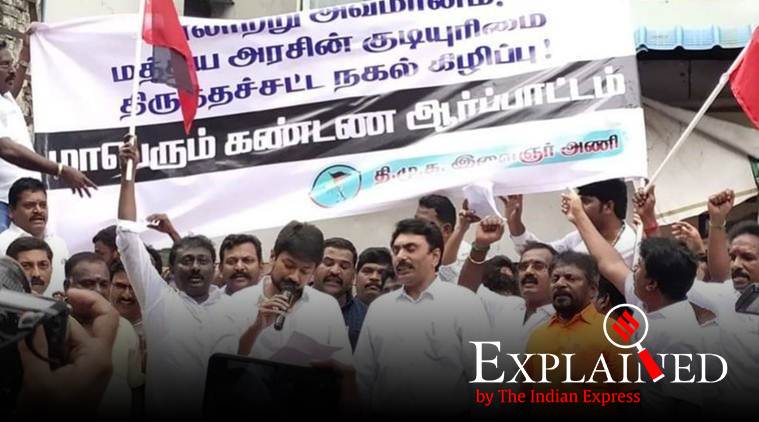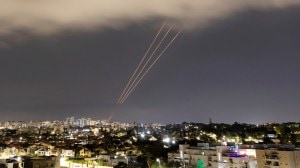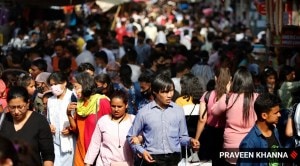- India
- International
Explained: How to read Citizenship Act in context of Tamil Nadu’s politics, refugees’ issue
When the AIADMK decided to support the citizenship Bill, it took the risk of being seen as abandoning the cause of over 1 lakh Lankan refugees living in camps for three decades.
 DMK workers protest against the Citizenship (Amendment) Bill in Chennai on Friday. (Twitter/@arivalayam)
DMK workers protest against the Citizenship (Amendment) Bill in Chennai on Friday. (Twitter/@arivalayam)
On Tuesday (December 17) the DMK organised protests across Tamil Nadu against the new citizenship law, accusing the BJP of destroying the country, and holding the AIADMK complicit for its Parliament vote in favour of the Bill.
At a rally in Kancheepuram, Leader of Opposition in the Assembly M K Stalin demanded citizenship for Indian-origin Tamils and Sri Lankan Tamil refugees living in camps in Tamil Nadu for the last three decades.
The question of the Tamil refugees fleeing the war and state repression in Sri Lanka was raised in Parliament. But during the debate on this and other questions, distinctions were sought to be made between refugees and intruders, and between people fleeing war and civil unrest and those fleeing religious persecution.
So, who is a Tamil refugee?
There are five identified categories.
* People living in the camps that are being run by the government across Tamil Nadu.

* People who do not actually live in a camp, but who have a refugee certificate from the district Collector, and are registered with the nearest police station. There are about 30,000 such people.
* Sri Lankan nationals who originally had valid travel documents, but who stayed on even after their visas expired; some among this group seek to use India as their launchpad to Europe.
* Former Tamil militants who have been kept in special camps.
* Refugees who have arrived in Tamil Nadu after the war in Sri Lanka ended with the defeat of the LTTE in 2009. Some of these people arrived with help from the Sri Lankan navy, either in search of a livelihood, or sometimes to take a boat from Kerala to another country, which is often Australia. (Over 200 people are believed to have sailed for New Zealand from Kerala in January this year in a boat so packed that many of them had to leave their luggage behind.)
And what is the number of Tamil refugees in India?
In January 2015, then Chief Minister O Panneerselvam wrote to the Prime Minister’s Office saying there were a total of 1,02,055 refugees belonging to 34,524 families in Tamil Nadu. Out of these, 64,924, belonging to 19,625 families, were living in 107 refugee camps.
Read | AIADMK MP removed from Jamaat bodies in Tamil Nadu over citizenship law
When did these refugees arrive in Tamil Nadu?
There were four distinct waves of arrivals.
* The first began in July 1983. This was in the context of “Black July”, the anti-Tamil violence that began after 13 Sri Lankan soldiers were killed by the Tamil Tigers on July 23, 1983.
Rampaging Sinhala mobs butchered hundreds of Tamils in retaliation, and triggered an exodus to India that continued till 1987, when the India-Sri Lanka Accord was signed between Prime Minister Rajiv Gandhi and President Junius Jayawardene.
In the four years from 1983 to 1987, at least 1.34 lakh Sri Lankan Tamils officially arrived in India, mostly in Tamil Nadu. After the Accord was signed, charter ships travelled between India and Sri Lanka for those who chose to return.
Between 1987 and 1989, some 25,600 refugees went back to Sri Lanka, according to official records.
* In 1990, the Sri Lanka-LTTE war flared up again, and triggered another round of exodus. This time, some 1,22,000 Tamils arrived in India, and many of the refugees also started to migrate to Europe and Canada.
An LTTE suicide bomber assassinated Rajiv Gandhi on May 21, 1991, and between 1992 and 1995, an estimated 54,000 refugees were repatriated to Sri Lanka.
* A third wave of refugees started arriving in 1995, when the war intensified. Between 1995 and 2002, some 23,000 arrived in Tamil Nadu.
* The fourth wave coincided with the Sri Lankan army taking the war into the LTTE strongholds in the north. Refugees continued to pour into India until 2013, four years after the final defeat of the LTTE and the death of Velupillai Prabhakaran.
So, how should the DMK’s protest be read politically?
The cause of the Sri Lankan Tamils is a prominent issue in the politics of Tamil Nadu.
When the AIADMK decided to support the citizenship Bill — which provides for citizenship only to “persecuted” non-Muslims from Pakistan, Bangladesh, and Afghanistan — it took the risk of being seen as abandoning the cause of over 1 lakh Lankan refugees living in camps for three decades.
The absence of belligerence was a departure from the line the AIADMK has traditionally taken — both the party founder M G Ramachandran, and former Chief Minister J Jayalalithaa were empathetic to the cause of the Sri Lankan Tamil refugees.
The AIADMK’s acquiescence has given the DMK both a stick to beat it with, and an opportunity to claim that it alone is the voice of the refugees. Stalin said in Kancheepuram that the Bill could not have been passed in Rajya Sabha had the AIADMK voted against it.
“This party (AIADMK) played a major role in leading this country into chaos. India is burning now, and AIADMK is the reason,” he said. The BJP, Stalin alleged, was “least bothered” about the Sri Lankan Tamil refugees, and the AIADMK had “made this compromise to continue their business of looting the state”.
The DMK, Stalin said, was not like the “Edappadi group”, referring to Chief Minister Edappadi K Palaniswami. “We do not remain mute spectators when you destroy the basic ethos of this country. We belong to the group of Thanthai Periyar (leader of the Dravidar Kazhagam E V Ramasamy ‘Periyar’), C N Annadurai (founder of the DMK) and M Karunanidhi (the late CM and DMK leader). When there are so many crucial issues before them (the central government) to address and resolve immediately, they were in a hurry to implement this Act, instead of helping the people.”
Don’t miss from Explained | Jaipur blasts: What was the 2008 terror attack for which 4 men have been convicted?
More Explained
EXPRESS OPINION
Apr 19: Latest News
- 01
- 02
- 03
- 04
- 05








































